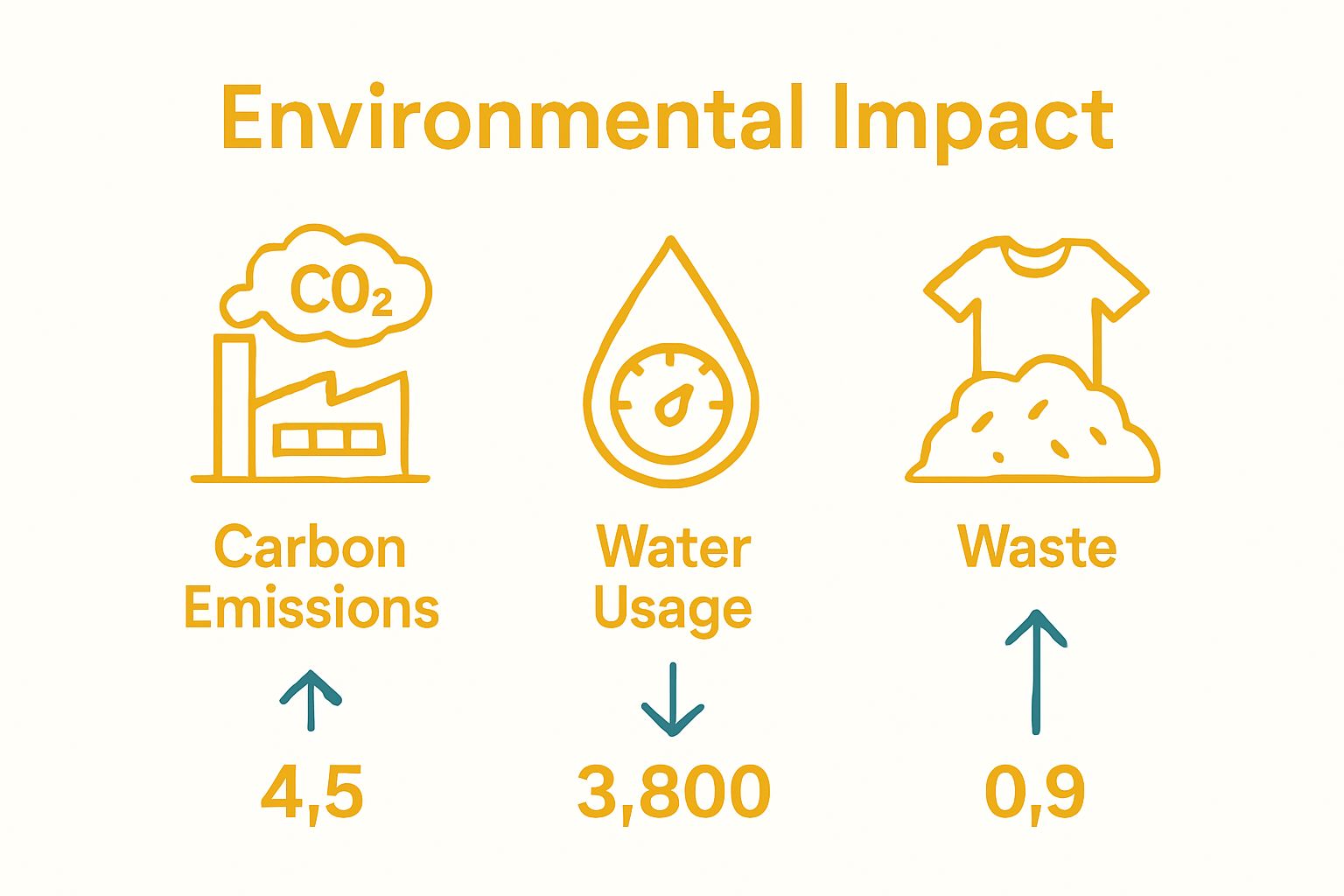Why Sustainable Fashion Matters
- Emma

- Oct 20
- 9 min read

Sustainable fashion is reshaping wardrobes and changing the way we think about what we wear. The fashion sector is responsible for 10% of annual global carbon emissions, which is more pollution than all international flights and maritime shipping combined. Surprisingly, the real transformation in fashion is not just about fabric choices or new styles. It is about challenging the entire fast fashion mindset and turning each purchase into an act of environmental and social responsibility. Here we look at why sustainable fashion matters...
Table of Contents
Why Sustainable Fashion Matters: A Quick Summary
Takeaway | Explanation |
Prioritise sustainable materials in fashion | Choose organic, recycled, or plant-based textiles to reduce environmental impact during manufacturing. |
Support ethical labour practices | Advocate for fair wages and safe conditions for workers in the fashion supply chain. |
Embrace circular economy principles | Opt for clothes designed for recycling or upcycling, extending garment lifecycles and reducing waste. |
Reduce consumption for a more sustainable future | Focus on purchasing durable, timeless pieces rather than disposable fast fashion to minimise overall waste. |
Engage with responsible brands | Demand transparency and ethical practices from fashion companies to foster systemic change in the industry. |
Defining Sustainable Fashion: A Clear Explanation
Sustainable fashion represents a comprehensive approach to clothing production and consumption that prioritises environmental responsibility, ethical practices, and long-term social impact. Unlike traditional fashion models that focus solely on aesthetic trends and mass production, sustainable fashion integrates ecological consciousness with design, manufacturing, and consumer behaviour.
The Core Principles of Sustainable Fashion
At its heart, sustainable fashion encompasses several fundamental principles that transform how clothing is conceived, created, and consumed. These principles go far beyond merely selecting organic fabrics or reducing waste.
Environmental Stewardship: Minimising carbon footprint and reducing ecological harm through responsible manufacturing processes
Ethical Labour Practices: Ensuring fair wages, safe working conditions, and humane treatment of workers throughout the supply chain
Circular Economy Design: Creating garments that can be recycled, upcycled, or biodegraded at the end of their lifecycle
According to McKinsey & Company, the fashion industry currently accounts for 4% of global greenhouse gas emissions, highlighting the urgent need for sustainable transformation.
Understanding Sustainable Fashion’s Holistic Approach
Sustainable fashion is not a single strategy but a multifaceted approach involving designers, manufacturers, consumers, and policymakers. It requires reimagining fashion as a system where environmental and social considerations are as important as aesthetic and economic factors.
This approach means carefully selecting materials with low environmental impact, such as organic cotton, recycled polyester, or innovative plant-based textiles. It also involves creating timeless designs that transcend seasonal trends, reducing the constant demand for new clothing and promoting a more conscious consumption model.
Ultimately, sustainable fashion challenges us to view clothing not as disposable commodities, but as valuable resources with significant environmental and social implications. By understanding and supporting these principles, consumers can contribute to a more responsible and ethical fashion ecosystem.
To help readers distinguish the key pillars underpinning sustainable fashion, here is a table comparing core principles and their aims as described in the article.
Principle | Key Aim | Example Action |
Environmental Stewardship | Minimise ecological harm and carbon footprint | Use of organic or recycled materials |
Ethical Labour Practices | Ensure fair and humane treatment for workers | Fair wages, safe factory conditions |
Circular Economy Design | Extend garment lifecycles and encourage recyclability | Designing clothes for recycling or upcycling |
Holistic Approach | Integrate environmental and social considerations | Collaboration among designers, manufacturers, consumers |
Transparency in Supply Chain | Provide accountability and traceability | Independent audits, public reporting of wage and conditions |
The Environmental Impact: Why It Matters
The fashion industry’s environmental footprint is significantly larger and more complex than most consumers realise. From raw material extraction to final garment disposal, every stage of clothing production contributes to substantial ecological challenges that demand immediate and transformative action.
Carbon Emissions and Climate Change
The textile industry is a major contributor to global carbon emissions, with clothing production generating more greenhouse gases than international maritime shipping and international flights combined.
The United Nations Environment Programme reports that the fashion sector is responsible for 10% of annual global carbon emissions.
Textile Manufacturing: Extremely energy-intensive processes that rely heavily on fossil fuels
Transportation Logistics: Global supply chains require significant fuel consumption
Synthetic Material Production: Petroleum-based fabrics create substantial carbon footprints
Water Pollution and Resource Depletion
Textile manufacturing is notorious for its devastating water consumption and contamination patterns. Cotton production, for instance, requires enormous water volumes while simultaneously introducing toxic chemicals into water systems. According to World Resources Institute, a single cotton shirt can consume up to 2,700 litres of water during its production cycle.

The environmental consequences extend beyond water usage. Microplastic shedding from synthetic garments represents another critical ecological challenge, with millions of microscopic plastic particles entering marine ecosystems through washing processes.
Waste and Landfill Challenges
Fast fashion’s disposable model has created unprecedented waste management problems. Worn Again Technologies indicates that less than 1% of materials used in clothing production are ultimately recycled into new garments, with most textiles ending up in landfills or incineration facilities.
Consumers play a crucial role in mitigating these environmental challenges. By choosing sustainable fashion, supporting circular economy principles, and extending garment lifecycles, individuals can contribute to meaningful ecological transformation. The environmental impact of fashion is not just an industry problem but a collective responsibility that requires systemic change and individual commitment.
To clarify the multiple types of environmental consequences mentioned, here is a summary table encapsulating the main environmental impacts of the fashion industry detailed in the article.
Environmental Impact | Description | Example/Statistic |
Carbon Emissions | Significant greenhouse gas emissions from manufacturing and logistics | 10% of annual global carbon emissions |
Water Use and Pollution | High water consumption and contamination from chemical-intensive processes | Up to 2,700 litres of water for a single cotton shirt |
Microplastic Pollution | Shedding of microscopic plastics from synthetic garments into marine ecosystems | Millions of particles per wash |
Textile Waste and Landfills | Large volumes of clothing disposed of in landfills or incinerated | Less than 1% of materials recycled into new garments |
Resource Depletion | Depletion of natural resources, especially in cotton and synthetic production | Extensive use of fossil fuels and arable land |
Economic Benefits: Supporting Local and Ethical Practices
Sustainable fashion transcends environmental considerations, offering profound economic advantages that support local communities, promote ethical manufacturing, and create more resilient economic models. By prioritising fair labour practices and local production, sustainable fashion challenges traditional globalised supply chains.
Local Manufacturing and Economic Empowerment
Sustainable fashion models prioritise local manufacturing, creating significant economic opportunities for communities. The Business of Fashion highlights that localised production can reduce carbon emissions by up to 50% while generating meaningful employment in regional economies.
Direct Community Investment: Creating jobs in local textile and garment production
Skill Preservation: Maintaining traditional craftsmanship and artisanal techniques
Economic Resilience: Reducing dependency on global supply chains
Fair Labour Practices and Wage Equity
Ethical fashion fundamentally challenges exploitative labour practices prevalent in traditional manufacturing. According to International Labour Organization, sustainable fashion brands commit to providing living wages, safe working environments, and comprehensive worker protections.
Key Economic Benefits include:
Reducing income inequality
Improving worker quality of life
Creating transparent and accountable supply chains
Long-Term Economic Sustainability
Sustainable fashion represents a more economically intelligent approach to clothing production. Worn Again Technologies demonstrates that circular economy models can generate significant economic value by transforming waste into resource streams.
By investing in durable, high-quality garments that transcend seasonal trends, consumers participate in an economic model that values longevity over disposability. This approach reduces overall consumption, generates less waste, and creates more stable economic ecosystems within the fashion industry.
The economic potential of sustainable fashion extends far beyond individual purchasing decisions.
To illuminate the main economic aspects and benefits mentioned, here is a table outlining the economic contributions of sustainable fashion.
Economic Aspect | Benefit/Impact | Example from Content |
Local Manufacturing | Creates jobs and preserves skills | Generates employment, supports craftsmanship |
Fair Labour and Wage Equity | Reduces inequality, improves quality of life | Living wages and better working environments |
Economic Resilience | Less dependent on global supply chains | Supports regional economies |
Circular Economy Value | Transforms waste into resources, adds economic value | Durable and high-quality garments extend product life |
Stable Consumption Patterns | Focus on longevity over disposability | Reduces overall consumption and waste |

Social Responsibility: The Human Cost of Fashion
Beyond environmental concerns, sustainable fashion addresses critical social issues embedded within global textile and clothing production systems. The human cost of traditional fashion manufacturing reveals profound ethical challenges that demand comprehensive transformation and conscious consumer engagement.
Labour Exploitation and Working Conditions
International Labour Organization estimates that over 170 million children are engaged in child labour worldwide, with significant proportions working in textile and garment manufacturing. These startling statistics highlight the urgent need for ethical production practices.
Systemic Inequality: Perpetuating poverty through low-wage labour models
Health Risks: Exposure to hazardous chemicals and unsafe working environments
Limited Worker Rights: Restricted collective bargaining and workplace protections
Gender Dynamics in Textile Production
Women represent approximately 80% of garment workers globally, yet they consistently experience disproportionate levels of workplace discrimination and economic marginalisation. According to UN Women, female textile workers frequently encounter sexual harassment, unequal pay, and limited career advancement opportunities.
Transparency and Ethical Supply Chains
Sustainable fashion champions transparency as a fundamental principle for social responsibility. Understanding the advantages of sustainable fashion requires recognising the importance of traceability and accountability in global manufacturing networks.
Key Transparency Principles:
Documenting worker treatment and compensation
Ensuring safe and dignified working conditions
Implementing independent auditing mechanisms
By demanding ethical practices, consumers can drive meaningful change in an industry historically characterised by systemic exploitation. Sustainable fashion represents more than an environmental movement it is a crucial mechanism for promoting human dignity, economic justice, and global social equity.
The Future of Fashion: Innovations and Trends
Sustainable fashion is rapidly evolving, driven by technological innovations, shifting consumer consciousness, and urgent environmental imperatives. The future of fashion represents a complex intersection of design, technology, ethical practices, and ecological responsibility.
Technological Transformations in Textile Production
McKinsey & Company reports that emerging technologies are fundamentally reshaping clothing manufacturing. Innovations such as 3D printing, bio-fabrication, and advanced recycling techniques are creating unprecedented opportunities for sustainable textile production.
Bio-engineered Materials: Growing textiles from agricultural waste and microbial processes
Digital Fabrication: Reducing material waste through precise, computer-controlled manufacturing
Circular Design Technologies: Creating garments with built-in recyclability
Circular Economy and Material Innovation
The next generation of sustainable fashion will be defined by closed-loop systems that transform waste into valuable resources. Top 5 Iconic Vintage Pieces Making a Fashion Comeback in 2025 demonstrates how innovative design can blend historical aesthetics with cutting-edge sustainability principles.
Key Material Innovations:
Textiles created from recycled ocean plastics
Fabrics grown from mushroom and algae derivatives
Self-repairing smart textiles with embedded nanotechnology
Consumer Engagement and Systemic Change
The future of sustainable fashion extends beyond technological solutions. According to the Ellen MacArthur Foundation, true transformation requires comprehensive ecosystem redesign involving designers, manufacturers, policymakers, and consumers.
Consumers are increasingly demanding transparency, ethical production, and environmental accountability. This shift is driving fundamental changes in how clothing is conceived, produced, marketed, and consumed. The future of fashion is not just about creating beautiful garments, but about reimagining our relationship with clothing as a holistic, regenerative system that respects both human and ecological well-being.
Choose Vintage Fashion to Make a Real Difference
The article shows that fast fashion’s hidden costs run deep. Growing landfills, water pollution and ethical concerns are all direct effects of disposable trends. Many readers are looking for a way to break this cycle by embracing circular economy, ethical choices and truly original style. If you want clothing that reflects your values and stands for sustainability, vintage is the answer.
Now is the perfect time to commit to conscious fashion. At My Vintage, you can discover genuine vintage clothing with timeless quality that supports eco-friendly principles. Each piece from our curated collection helps reduce waste and celebrates individuality. Learn more about the advantages of sustainable fashion or find inspiration in our trend insights and articles that guide your next ethical purchase. Make your next style choice a step toward positive environmental and social change. Explore our full range at My Vintage and experience the power of mindful shopping today.
Frequently Asked Questions
What is sustainable fashion?
Sustainable fashion refers to a holistic approach to clothing production and consumption that prioritises environmental responsibility, ethical labour practices, and long-term social impact.
How does sustainable fashion impact the environment?
Sustainable fashion aims to minimise the fashion industry’s carbon emissions, reduce water pollution, and address waste challenges by promoting eco-friendly materials, responsible manufacturing processes, and circular economy principles.
What are the economic benefits of sustainable fashion?
Sustainable fashion supports local manufacturing, ethical labour practices, and promotes economic resilience by prioritising fair wages and creating job opportunities in communities, thus reducing dependency on exploitative global supply chains.
Why is social responsibility important in sustainable fashion?
Social responsibility is crucial as it addresses human costs associated with traditional fashion practices, including labour exploitation, unsafe working conditions, and gender inequality, thus promoting dignity and equity in the global garment industry.
Recommended








Comments